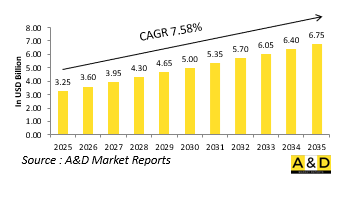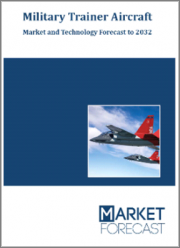
|
시장보고서
상품코드
1744376
세계의 연습기 시장(2025-2035년)Global Trainer Aircraft Market 2025-2035 |
||||||
세계의 연습기 시장 규모는 2025년 32억 5,000만 달러로 추정되고, 2035년까지 67억 5,000만 달러에 달할 것으로 예측되며, 예측 기간인 2025-2035년 CAGR 7.58%로 성장이 전망됩니다.

연습기 시장의 기술 영향
기술의 진보는 교습기의 능력을 재정의해 교습의 질과 작전에 대한 적응성을 함께 높이고 있습니다. 최신 연습기 플랫폼은 현재 디지털 콕핏, 터치스크린 인터페이스, 차세대 전투기와 흡사한 선진 아비오닉스를 통합하고 있습니다. 이러한 연계를 통해 훈련생은 훈련 초기 단계부터 조작에 익숙해질 수 있습니다. 임베디드형 시뮬레이션 시스템은 점점 일반화되고 있으며, 같은 비행 세션 내에서 실제 비행과 가상 훈련을 혼재시킬 수 있습니다. 이러한 기능을 통해 외부 시뮬레이터에 대한 의존을 줄이고 역동적인 작전 리허설이 가능해집니다. 실시간 데이터 모니터링과 자동 복귀 시스템 등 강화된 안전 메커니즘은 강사가 필요할 때 즉시 개입할 수 있도록 함으로써 지도를 더욱 지원합니다. 선진 추진 시스템도 성능을 향상시켜 보다 폭넓은 비행 조건을 재현할 수 있게 되어 있습니다. 현재 일부 플랫폼은 데이터 링크와 작전 계획 소프트웨어를 지원하고 있으며, 기타 항공 또는 지상 자산과 함께 네트워크화된 훈련에 참여할 수 있습니다. 또한 재료와 공기역학의 발전으로 내용연수가 늘어나 유지보수의 필요성이 감소하고 있습니다. 이러한 기술적 전환으로 연습기는 단순한 발판이 아니라 그 자체로 전략적 자산이 되어 군사 항공 교육의 모든 단계에서 훈련 비용, 안전성, 동작의 현실성을 최적화하면서 선진 시스템을 조작하는 파일럿을 양성할 수 있습니다.
연습기 시장의 주요 촉진요인
공중전의 복잡화 및 최전선 항공기의 정교함이 방위용 연습기의 진화를 형성하는 큰 힘이 되고 있습니다. 공군이 멀티롤 플랫폼과 스텔스 플랫폼으로 플릿을 현대화함에 따라 유사한 조종석 환경, 작전 시스템, 작전 역학을 재현할 수 있는 연습기가 병행 필요합니다. 예산 효율도 촉진 요인이며, 연습기는 정기적인 훈련을 위해 고성능 전투기를 전개하는 비용 없이 조종사의 기능을 향상시키는 비용 대비 효과가 높은 수단을 제공합니다. 또한 조종사의 즉응성을 높이면서 훈련기간을 단축하는 것이 요구되기 때문에 실비행, 시뮬레이션, 작전계획을 통일적인 프레임워크로 통합하는 블렌디드 러닝 접근법을 지원하는 플랫폼에 대한 수요도 높아지고 있습니다. 공동훈련 및 연합훈련의 노력은 동맹국의 표준과 호환되며 국제적인 파일럿 교류를 지원할 수 있는 연습기의 필요성을 더욱 강하게 보여줍니다. 무인 시스템의 등장과 유무인 팀 편성 능력의 필요성도 훈련 요건에 영향을 주고 있어, 이러한 진화하는 작전 프로파일을 시뮬레이션 할 수 있는 항공기의 개발을 재촉하고 있습니다. 종합적으로, 이러한 요인은, 훈련 환경으로부터 현대의 항공 작전의 다면적인 과제로 심리스하게 이행할 수 있는, 적응력이 있는 즉전력의 항공기 승무원을 육성하는 방향으로의 폭넓은 시프트를 반영하고 있습니다.
연습기 시장의 지역 동향
방위용 연습기 프로그램은 지역에 따라 크게 달라 군의 우선순위, 산업 능력, 전략적 파트너십에 의해 형성되고 있습니다. 유럽에서는, 근대화 활동으로서, 최전선의 NATO기에서 사용되고 있는 디지털 작전 시스템과 호환성이 있는 연습기 플랫폼으로 노후화된 플릿을 대체하는 것이 중시되고 있습니다. 이러한 프로그램은 종종 상호 운용성 및 공동 훈련 표준을 중시하고 있습니다.
본 보고서에서는 세계의 연습기 시장에 대해 조사 분석했으며, 성장 촉진요인, 향후 10년간의 전망, 각 지역 동향 등의 정보를 제공합니다.
목차
연습기 시장 보고서 정의
연습기 시장 세분화
지역별
유형별
최종 사용자별
향후 10년간 연습기 시장 분석
연습기 시장 기술
세계의 연습기 시장 예측
지역 연습기 시장 동향 및 예측
북미
촉진요인, 억제요인 및 과제
PEST
시장 예측 및 시나리오 분석
주요 기업
공급자의 Tier 상황
기업 벤치마킹
유럽
중동
아시아태평양
남미
연습기 시장 국가 분석
미국
방위 프로그램
최신 뉴스
특허
이 시장의 현재 기술 성숙도
시장 예측 및 시나리오 분석
캐나다
이탈리아
프랑스
독일
네덜란드
벨기에
스페인
스웨덴
그리스
호주
남아프리카
인도
중국
러시아
한국
일본
말레이시아
싱가포르
브라질
연습기 시장 기회 행렬
연습기 시장 보고서에 대한 전문가의 의견
결론
항공 및 방위 시장 보고서 정보
AJY 25.06.18The Global Trainer Aircraft market is estimated at USD 3.25 billion in 2025, projected to grow to USD 6.75 billion by 2035 at a Compound Annual Growth Rate (CAGR) of 7.58% over the forecast period 2025-2035.

Introduction to Trainer Aircraft Market:
Trainer aircraft form a foundational element in preparing military pilots for operational duty. These specialized aircraft are used to bridge the gap between basic flight instruction and the complex demands of modern combat aviation. They provide a controlled environment where aspiring aviators can master navigation, maneuvering, and mission-specific skills before transitioning to frontline fighter, bomber, or reconnaissance platforms. Trainer aircraft are typically categorized into basic, intermediate, and advanced levels, each offering progressively complex systems and flight dynamics. These platforms allow air forces to conduct cost-effective training without exposing expensive frontline assets to routine instruction or potential risk. Their design emphasizes safety, reliability, and modularity, enabling both simulated and live training in varied conditions. Beyond pilot development, trainer aircraft are increasingly used for systems familiarization, sensor training, and joint exercises. As air power remains a critical pillar of modern defense strategy, the role of trainer aircraft continues to expand, ensuring that aircrew are proficient, mission-ready, and able to adapt to the evolving dynamics of aerial warfare. Their significance extends beyond the cockpit, contributing to the overall efficiency and readiness of air forces in both peacetime and conflict scenarios.
Technology Impact in Trainer Aircraft Market:
Technological advancement is redefining the capabilities of trainer aircraft, enhancing both instructional quality and mission adaptability. Modern trainer platforms now integrate digital cockpits, touchscreen interfaces, and advanced avionics that closely resemble those of next-generation combat aircraft. This alignment allows trainees to develop operational familiarity early in their progression. Embedded simulation systems are increasingly common, enabling a mix of live flying and virtual training within the same flight session. These features reduce dependency on external simulators and offer dynamic mission rehearsal capabilities. Enhanced safety mechanisms such as real-time data monitoring and automatic recovery systems further support instruction by allowing instructors to intervene instantly when needed. Advanced propulsion systems also improve performance, allowing trainers to replicate a broader spectrum of flight conditions. Some platforms now support data links and mission planning software, enabling participation in networked training exercises alongside other air or ground assets. Additionally, developments in materials and aerodynamics have led to longer service life and reduced maintenance demands. These technological shifts ensure that trainer aircraft are not just stepping stones but strategic assets in themselves, preparing pilots to operate sophisticated systems while optimizing training costs, safety, and operational realism across all phases of military aviation instruction.
Key Drivers in Trainer Aircraft Market:
The growing complexity of aerial warfare and the increasing sophistication of frontline aircraft are major forces shaping the evolution of defense trainer aircraft. As air forces modernize their fleets with multirole and stealth platforms, there is a parallel need for training aircraft that can replicate similar cockpit environments, mission systems, and operational dynamics. Budget efficiency is another driving factor, with trainer aircraft offering a cost-effective means to develop pilot skills without the expense of deploying high-performance combat jets for routine instruction. The requirement to reduce training timelines while increasing pilot readiness has also led to the demand for platforms that support a blended learning approach-integrating live flight, simulation, and mission planning into a unified framework. Joint and coalition training initiatives further underscore the need for trainer aircraft compatible with allied standards and capable of supporting international pilot exchanges. The emergence of unmanned systems and the need for manned-unmanned teaming capabilities have also influenced training requirements, prompting the development of aircraft that can simulate these evolving mission profiles. Taken together, these drivers reflect a broader shift toward creating adaptable, future-ready aircrews who can seamlessly transition from training environments to the multifaceted challenges of modern aerial operations.
Regional Trends in Trainer Aircraft Market:
Defense trainer aircraft programs vary widely by region, shaped by distinct military priorities, industrial capabilities, and strategic partnerships. In Europe, modernization efforts focus on replacing aging fleets with trainer platforms that are compatible with digital mission systems used in frontline NATO aircraft. These programs often emphasize interoperability and joint training standards. In North America, emphasis is placed on advanced jet trainers that can prepare pilots for the complexities of fifth-generation aircraft and integrated combat operations. Training is increasingly networked, reflecting the high-tech nature of the region's broader defense architecture. Asia-Pacific nations are rapidly expanding pilot development capabilities, driven by growing air force modernization and the need to support both indigenous and imported combat platforms. Some countries in this region are also investing in domestic trainer production, reflecting strategic goals of self-reliance and defense industrial growth. The Middle East, facing a dynamic security landscape, prioritizes rapid pilot development and often acquires versatile, export-ready trainers that can support both instruction and light attack roles. Latin America and Africa, while more constrained by budgets, continue to invest in multi-role trainer platforms as part of broader air capability enhancements. Each region's approach reflects its operational needs, threat perceptions, and future air power ambitions.
Key Trainer Aircraft Program:
Textron Aviation has been awarded a $277 million contract to manufacture T-54A next-generation trainer aircraft for the U.S. military. Under procurement lots 2 and 3, the company will supply 26 aircraft to the U.S. Navy, Marine Corps, and Coast Guard. The contract also includes the provision of spare engines and related support equipment. Production will take place in Kansas and Texas, with project completion expected by September 2026. The T-54A is anticipated to enhance pilot training capabilities across U.S. military branches once delivered.
.
Table of Contents
Trainer Aircraft Market Report Definition
Trainer Aircraft Market Segmentation
By Region
By Type
By End User
Trainer Aircraft Market Analysis for next 10 Years
The 10-year trainer aircraft market analysis would give a detailed overview of trainer aircraft market growth, changing dynamics, technology adoption overviews and the overall market attractiveness is covered in this chapter.
Market Technologies of Trainer Aircraft Market
This segment covers the top 10 technologies that is expected to impact this market and the possible implications these technologies would have on the overall market.
Global Trainer Aircraft Market Forecast
The 10-year trainer aircraft market forecast of this market is covered in detailed across the segments which are mentioned above.
Regional Trainer Aircraft Market Trends & Forecast
The regional Trainer Aircraft Markettrends, drivers, restraints and Challenges of this market, the Political, Economic, Social and Technology aspects are covered in this segment. The market forecast and scenario analysis across regions are also covered in detailed in this segment. The last part of the regional analysis includes profiling of the key companies, supplier landscape and company benchmarking. The current market size is estimated based on the normal scenario.
North America
Drivers, Restraints and Challenges
PEST
Market Forecast & Scenario Analysis
Key Companies
Supplier Tier Landscape
Company Benchmarking
Europe
Middle East
APAC
South America
Country Analysis of Trainer Aircraft Market
This chapter deals with the key defense programs in this market, it also covers the latest news and patents which have been filed in this market. Country level 10 year market forecast and scenario analysis are also covered in this chapter.
US
Defense Programs
Latest News
Patents
Current levels of technology maturation in this market
Market Forecast & Scenario Analysis
Canada
Italy
France
Germany
Netherlands
Belgium
Spain
Sweden
Greece
Australia
South Africa
India
China
Russia
South Korea
Japan
Malaysia
Singapore
Brazil
Opportunity Matrix for Trainer Aircraft Market
The opportunity matrix helps the readers understand the high opportunity segments in this market.
Expert Opinions on Trainer Aircraft Market Report
Hear from our experts their opinion of the possible analysis for this market.












